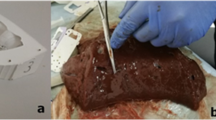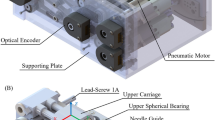Abstract
The existing interventional therapy robots for the microwave ablation of liver tumors have a poor clinical applicability with a large volume, low positioning speed and complex automatic navigation control. To solve above problems, a composite configuration interventional therapy robot with passive and active joints is developed. The design of composite configuration reduces the size of the robot under the premise of a wide range of movement, and the robot with composite configuration can realizes rapid positioning with operation safety. The cumulative error of positioning is eliminated and the control complexity is reduced by decoupling active parts. The navigation algorithms for the robot are proposed based on solution of the inverse kinematics and geometric analysis. A simulation clinical test method is designed for the robot, and the functions of the robot and the navigation algorithms are verified by the test method. The mean error of navigation is 1.488 mm and the maximum error is 2.056 mm, and the positioning time for the ablation needle is in 10 s. The experimental results show that the designed robot can meet the clinical requirements for the microwave ablation of liver tumors. The composite configuration is proposed in development of the interventional therapy robot for the microwave ablation of liver tumors, which provides a new idea for the structural design of medical robots.
















Similar content being viewed by others
References
Zhu-Huang Zhou, Qi-Ying Ding, Lei Sheng, et al. Advances in noninvasive monitoring of thermal therapy with ultrasound elasticity imaging. Beijing Biomedical Engineering, 2013, 32(6): 641–646. (in Chinese)
Zhu-Huang Zhou, Wei-Wei Wu, et al. Advances in image navigation techniques for tumor thermal ablation. Beijing Biomedical Engineering, 2014, 33(4): 415–419. (in Chinese)
Zhu-Huang Zhou, Wei-Wei Wu, Shui-Cai Wu, et al. Recent advances in noninvasive ultrasound monitoring of thermal therapy for tumors. Science & Technology Review, 2014, 32(20): 19–24.
Wei-Wei Wu, Zhu-Huang Zhou, Shui-Cai Wu, et al. A survey of intraoperative image registration approaches to ultrasound guided interventional therapy. Beijing Biomedical Engineering, 2015, 34(6): 639–645. (in Chinese)
J Hong, T Dohi, M Hashizume, et al. An ultrasound-driven needle-insertion robot for percutaneous cholecystectomy. Physics in Medicine and Biology, 2004, 49(3): 441–455.
E M Boctor, G Fischer, M A Choti, et al. A dual-armed robotic system for intraoperative ultrasound guided hepatic ablative therapy//Proceedings of the 2004 IEEE International Conference on Robotics & Automation, Piscataway, NJ, USA, April 26–May 1, 2004, 3(26): 2517–2522.
R Taylor, P Jensen, L Whitcomb. A steady-hand robotic system for microsurgical augmentation. International Journal of Robotics Research, 1999, 18(12): 1201–1210.
Ying-Yu Cao, Shuang-Cheng Deng, Wei-Tao Cui, et al. A study of ultrasound-guided robot system for liver cancer coagulation therapy. Journal of Beijing Institute of Petro-chemiaclal Technology, 2012, 20(4): 1–6. (in Chinese)
Shuang-Cheng Deng, Li-Pei Jiang, Ying-Yu Cao, et al. A needle-holding robot for ultrasound guided percutaneous hepatic microwave ablation and initial experiments. The 1st Conference on Intelligent Robotics and Applications, Wuhan, China, October 15–17, 2008: 1173–1182.
Ying-Yu Cao, Bo-Jin Qi, Shao-Xian Wang, et al. The navigation and positioning method of active plus passive ultrasound-guided robot for liver cancer coagulation therapy. Advanced Materials Research, 2013, 17(8): 1453–1459.
Jing Xu, Zheng-Zhong Jia, Zhang-Jun Song, et al. The robotic system of microwave coagulation therapy for liver cancer based on ultrasound navigation. Robot, 2007, 29(5): 456–462. (in Chinese)
Jing Xu, Ken Chen, Xiang-Dong Yang, et al. Intra-operation 3D ultrasound navigation system in intervention therapy for liver cancer. Chinese Journal of Biomedical Engineering, 2007, 26(5): 719–723.
Jing Xu, Xiang-Dong Yang, Sen-Qiang Hu, et al. Three-dimensional ultrasound image-guided robotic system for accurate microwave coagulation of malignant liver tumors. International Journal of Medical Robotics & Computer Assisted Surgery, 2010, 6(3): 256–268.
Xiang-Dong Yang, Jing Xu, Shao-Li Liu, et al. On error propagation of the ultrasound guided robot for liver cancer coagulation therapy. Robot, 2008, 30(5): 440–446. (in Chinese)
Xiao-Xia Ni, Xiao-Ling Yu, Yang Wang, et al. A study of ultrasound-guided percutaneous microwave ablation of adrenal tumor. Chinese Journal of Medical Imaging, 2011, 19(3): 185–189.
Min Xiong, Ken Chen, Xiang-Dong Yang, et al. Intervention robot system THMR-I and its clinical application. High Technology Letters, 2009, 19(12): 1281–1287.
Tong Lu, Ping Liang, Zhi-Gang Cheng. Effects of navigation and robot technology on percutaneous ultrasound-guided liver tumor ablation: accuracy and feasibility of clinical application. Journal of Clinical Rehabilitative Tissue Engineering Research, 2010, 14(4): 625–628.
Tong Lu, Jing Xu, Ping Liang, et al. A robot system for US-guided microwave ablation therapy(a pilot study). China Medical Devices Information, 2007, 13(3): 5–8.
Tong Lu, Ping Liang, Shuang-Cheng Deng, et al. A robot for image-guided percutaneous intervention: decoupled motion capability correlated to the positioning and orientation steps of the percutaneous intervention. Journal of Clinical Rehabilitative Tissue Engineering Research, 2009, 13(48): 9447–9450.
L Nouaille, M A Laribi, C A Nelson, et al. Design process for robotic medical tool guidance manipulators. Proceedings of the Institution of Mechanical Engineers Part C: Journal of Mechanical Engineering Science, 2015, 230(2): 259–275.
De-Dong Gao, Yong Lei, Hao-Jun Zheng. Needle steering for robot-assisted insertion into soft tissue:a survey. Chinese Journal of Mechanical Engineering, 2012, 25(4): 629–638.
M Giuatni, V Riboulet, C Duriez, et al. A combined force and thermal feedback interface for minimally invasive procedures simulation. IEEE/ASME Transactions on Mechatronics, 2013, 18(3): 1170–1181.
Li-Jing Wang, Xue-Li He, Hong-Peng Li. Development of a percentile based three-dimensional model of the buttocks in computer system. Chinese Journal of Mechanical Engineering, 2016, 29(3): 633–640.
A Gulhar, D Briese, P W Mewes, et al. Registration of a robotic system to a medical imaging system. IEEE/RSJ International Conference on Intelligent Robots and Systems, Magdeburg, Germany, September 28–October 2, 2015: 3208–3213.
H Aaimian, M D Naish, B Kiaii, et al. A chance-constrained programming approach to preoperative planning of robotic cardiac surgery under task-level uncertainty. IEEE Journal of Biomedical & Health Informatics, 2015, 19(2): 612–622.
O Weede. Knowledge-based system for port placement and robot setup optimization in minimally invasive surgery..IFAC Proceedings Volumes, 2012, 45(22): 722–728.
Xue Yang, Hong-Bo Wang, Li Su, et al. Operation and force analysis of the guide wire in a minimally invasive vascular interventional surgery robot system. Chinese Journal of Mechanical Engineering, 2015, 28(2): 249–257.
V F Munoz, J Fernandez-Dez-Lozano, J Gomez-De-Gabriel, et al. On laparoscopic robot design and validation. Integrated Computer-Aided Engineering, 2003, 10(3): 1426–1431.
Yi-Li Fu, Bo Pan, Zong-Peng Yang, et al. Design and realization of a control system for laparoscopic robot. Robot, 2008, 30(4): 340–345.
Shuang-Cheng Deng. Key Technologies in Surgical Robot for Ultrasound Guided Tumor Microwave Ablation Surgery. Beijing: Beihang University, 2016. (in Chinese)
Author information
Authors and Affiliations
Corresponding author
Additional information
Supported by National Natural Science Foundation of China (Grant No. 2013BAI01B01) and Science and Technology Planning Project of Beijing Education Commission of China (Grant No. KM201310017002)
Rights and permissions
About this article
Cite this article
Cao, YY., Xue, L., Qi, BJ. et al. Composite Configuration Interventional Therapy Robot for the Microwave Ablation of Liver Tumors. Chin. J. Mech. Eng. 30, 1416–1425 (2017). https://doi.org/10.1007/s10033-017-0141-1
Received:
Revised:
Accepted:
Published:
Issue Date:
DOI: https://doi.org/10.1007/s10033-017-0141-1




